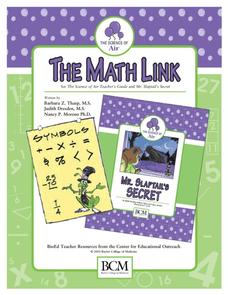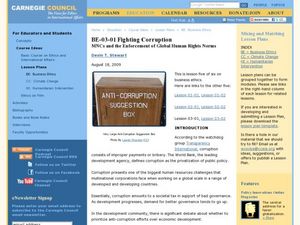Baylor College
Needs of Living Things: Post-Assessment
Assess your class's knowledge of the needs of living things with the final lesson in a series. Given a large piece of paper and coloring utensils, young scientists draw a picture of themselves and a plant or animal of their choosing,...
Baylor College
A Place to Be
Home sweet home. Humans, birds, beavers, ants, we all need a place place to rest and keep us safe. In the ninth lesson of this series, the importance of shelter is discussed as the teacher reads aloud the book Tillena Lou's Day in the...
Baylor College
Healthy Homes
Meant to follow a lesson plan about how concentrated air particles can be inside of a building, this resource gets individuals to assess the possible air pollutants in their own homes. They take home a worksheet and circle spots on it...
Baylor College
Fungus Among Us
In order to learn that mold spores can be found in the air, observers grow bread mold and make observations for a few days. Afterward, they participate in a class discussion to arrive at the knowledge that bread spores are present in the...
Baylor College
Food: The Math Link
Enrich your study of food science with with these math worksheets. They offer a variety of food-related word problems that are great practice for multiplying, identifying fractions, estimating length, and performing calculations...
Baylor College
Living Things and Their Needs: The Math Link
Enrich your study of living things with these cross-curricular math activities. Following along with the story Tillena Lou's Day in the Sun, learners will practice addition and subtraction, learn how to measure volume and length,...
Baylor College
Lungometer
Life science learners construct lung-o-meters from gallon-sized milk jugs and then measure their lung capacities. For older learners, have them graph the vital lung capacities of each person in the class. Cross-curricular pieces are...
Baylor College
Breathing Machine
Take a deep breath and have your class construct working models of a lung! Using 500ml plastic bottles as the chest cavity, and balloons for the lung and the diaphragm, learners work in groups to make a model. The models help them to...
Baylor College
What is Air? Pre-Assessment
First, estimate existing knowledge about air with a class discussion. Then, hand out a 10-question pre-assessment quiz to record how much pupils know to compare to their knowledge later. This will also give mini meteorologists the...
Baylor College
Gases Matter
As a demonstration or as a hands-on activity, your class watches as the combination of vinegar and baking soda produce carbon dioxide gas. The intent of the lesson is to help youngsters understand that gases occupy space. It is included...
Baylor College
Water: Post-Assessment
Very simply, the science class will discuss what they have learned during The Science of Water unit and take a multiple-choice post-assessment quiz. A few other closing activities are suggested for you to choose from, such as having...
Baylor College
Global Atmospheric Change: The Math Link
Change up the classroom atmosphere with this interdisciplinary resource. Following along with the children's book Mr. Slaptail's Curious Contraption, these math worksheets provide practice with a wide range of topics including...
Baylor College
Air: The Math Link
Inflate this unit on the science of air with these math skills practice and word problems. Accompanying the children's story Mr. Slaptail's Secret, this resource covers a wide range of math topics including the four basic...
PBS
The Elements
An attractive handout displays the periodic table of elements in full color. Each group has its own color, and each element is represented by its name, chemical symbol, atomic number, and atomic weight. What makes this periodic table...
Humanities Texas
Primary Source Worksheet: Letter from George Washington to the Cabinet
Analyze the significance of George Washington's letter to his cabinet in which he sets forth a tradition of neutrality in wartime for the United States.
Baylor College
Water: The Math Link
Make a splash with a math skills resource! Starring characters from the children's story Mystery of the Muddled Marsh, several worksheets create interdisciplinary connections between science, language arts, and math. They...
Facebook
Privacy and You
The stuff I share goes where? Social media scholars discover how sites collect and use metadata during a lesson about privacy and reputation. The activity demonstrates smart privacy settings and promotes good digital citizenship.
Curated OER
I Am A Musician- Interview A Musician
Students, as a class, interview musician to find out more about him/her as an individual. Students then write thank you notes and include, by naming or drawing, one fact learned about the musician.
Curated OER
The Void Filled by Nonprofits
Students examine the significance of nonprofit organizations in a democratic society. They conduct research on a selected nonprofit organization, complete a questionnaire, and present their findings to the class.
Curated OER
James Whitcomb Riley
Students describe James Whitcomb Riley's poems and identify the themes they portray. In this poetry lesson plan, students read the history of James Whitcomb Riley and read some of his poems.
Curated OER
Stitching Truth Lesson One: What is Civil Society?
Ninth graders create a working definition of civil society. In this US History lesson plan, 9th graders create a list of terms that help make up the term civil society. Students examine the case study of life in Pinochet's...
Curated OER
Four Sectors
Students explore the sectors of civil society. In this philanthropy lesson, students explore and categorize government, market, nonprofit, and household sectors.
Curated OER
Financial Planning for Catastrophe
Students examine the case of The Gulf Coast and relate it financial importance. In this financial planning lesson, students watch a video and then begin to analyze how to plan for the unexpected by reviewing the financial components that...
Curated OER
Fighting Corruption
Twelfth graders research the different types of business ethics. In this Economics lesson plan, 12th graders read various handouts on corruption. Students participate in a discussion on trying to end corruption.
Other popular searches
- Public and Private Goods
- Private vs. Public Goods
- Private vs Public Goods
- Private and Public Sector
- Private vs Public Domain
- Private vs. Public Domain
- Private and Public Behaviors
- Public and Private Property
- Private and Public Manners
- Public vs Private Property
- Public Private Property
- Public and Private Services























